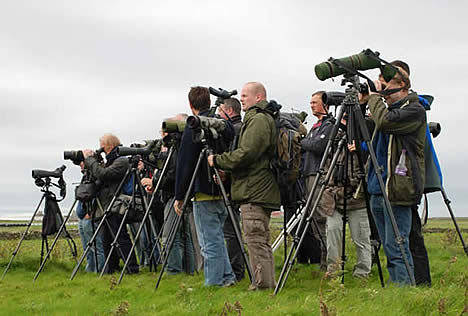Rare birds
Rarities on North Ronaldsay
North Ronaldsay’s prodigious potential as a site for finding rarebirds has been known for more than a century; the name is familiar today to all who have an interest in the phenomenon of bird migration and vagrancy in Britain. Its exposed position at the north of Orkney immediately grabs the attention of any keen rarity finder perusing a map of the Northern Isles, and the promise suggested by the island’s geographical location has been continually proven by the quantity and quality of vagrants that have been found here by those who have birded the island in past springs and autumns. The North Ronaldsay Bird Observatory, and the regular coverage of the island it has brought, has only been established since the mid 1980s – a relatively short time compared to some other observatories – but during this brief existence an impressive 341 species have been recorded: a list that includes a dazzling assortment of vagrant birds that usually feature only in the dreams of British birdwatchers.

Past megas that illustrate the island’s potential for attracting headline rarities have included Siberian Blue Robin, Rufous-tailed Robin, Yellow-browed Bunting and Cretzschmar’s Bunting, to name a few of our most famous finds. Thanks to its enviable location, North Ronaldsay regularly receives wanderers, including extreme rarities, from all points of the compass: Siberian Thrush, White’s Thrush, Eyebrowed Thrush, Yellow-browed Bunting and a staggering eight Pine Buntings have arrived from the east; 14 Blue-winged Teals, Veery, Yellow-rumped Warbler, Yellow Warbler, Buff-bellied Pipit, Yellow-billed Cuckoo, Dark-eyed Junco and White-throated Sparrow are among the transatlantic wanderers to have reached here from the west; overshooting migrants from the south have included Little Bustard, Squacco Heron, Calandra Lark and Spanish Sparrow; and Brünnich’s Guillemot, Ross’s Gull and Steller’s Eider are among the species that have strayed here from arctic latitudes. Given the regularity with which rare birds are found here, it is incredible that the island did not add an official first for Britain to its glittering résumé – although those who saw the Pallas’s Rosefinch or the Blue Rock Thrush, both snubbed by BOURC, might feel that we have been hard done by – until the Red-winged Blackbird in 2017.


Mega rarities aside, species such as White-billed Diver, Pectoral Sandpiper and Buff-breasted Sandpiper are near-annual. Both ‘lesser’ golden plovers occur with astonishing regularity: the island accounts for about ten percent of all British records of Pacific Golden Plover. Plenty of wader habitat often attracts other rare species such as White-rumped Sandpiper, another island speciality, whose occurrence here included a flock of seven in October 2005. Rare ducks and geese frequently appear among the large flocks of common species that inhabit the inland lochs and sheltered coastal bays, with American Wigeon, Green-winged Teal and King Eider appearing multiple times in recent years. Seawatching in the autumn can be fantastic when huge numbers of common seabirds pass by, often in the company of scarcer birds: dozens of Great Shearwaters have been seen on some days and there are several records of Fea’s Petrel.
For many birders, the real magic of migration hotspots like North Ronaldsay lies in the variety of migrant warblers, chats, thrushes and other songbirds that pass through the island on their annual journeys to and from their breeding grounds. These small visitors invariably include rarities amongst their number each year. Some of our most frequent such species include Olive-backed Pipit (14 records), Citrine Wagtail (10), Blyth’s Reed Warbler (10), Arctic Warbler (13) and Yellow-breasted Bunting (6). Lesser rarities such as Little Bunting, Rustic Bunting and Ortolan Bunting, Pallas’s Warbler, Short-toed Lark and Red-breasted Flycatcher all appear regularly and this is a fantastic place to see Arctic Redpoll in the UK – birds are seen almost every year, often several in a year, and include both subspecies.



For a small island with its own bird observatory, it seems strange that North Ronaldsay has been described as under-watched; but it is true that a great many rare birds here must go undetected, slipping quietly under the noses of the few resident birders for whom searching the entire island every day is an impossible task. There is a vast amount of cover for birds to hide in, including several dense iris beds, vast fields of impenetrable thistles, mile upon mile upon mile of sheltered dry stone walls, and countless nooks, crannies and other attractive sites for migrants that are distributed quite evenly across the whole island, making a complete, thorough daily census a frustratingly unattainable aim for the observatory’s small team of wardens. The comparatively few records of small, skulking species such as Lanceolated Warbler and Pallas’s Grasshopper Warbler is presumably due to the abundance of low vegetation for the birds to vanish into, and increased observer coverage would surely result in more of these secretive Locustellas being found. This does mean, though, that the rarity finding possibilities for visiting birders are truly mouth-watering: there is plenty of untapped habitat to work each day, and the resident ornithologists always welcome any extra pairs of birding eyes to the island.

Undoubtedly, North Ronaldsay has huge potential and rewards for those willing to put in the effort here during the migration seasons. If you are keen to find your own rare birds, there can be few sites in the country with more potential. The observatory is the perfect base from which to explore the island’s birding opportunities. Experienced ornithological staff are on hand to share news of their sightings and to offer advice about the best spots on the island and making the most of your stay. If you are looking for the ideal location for your next rare-finding expedition, look no further than North Ronaldsay for all the exciting possibilities of Northern Isles birding at its very best.
For details of how to book your stay at the observatory, please see this page.
For some more pictures of past rares to whet the appetite, check out our Rarity Gallery
